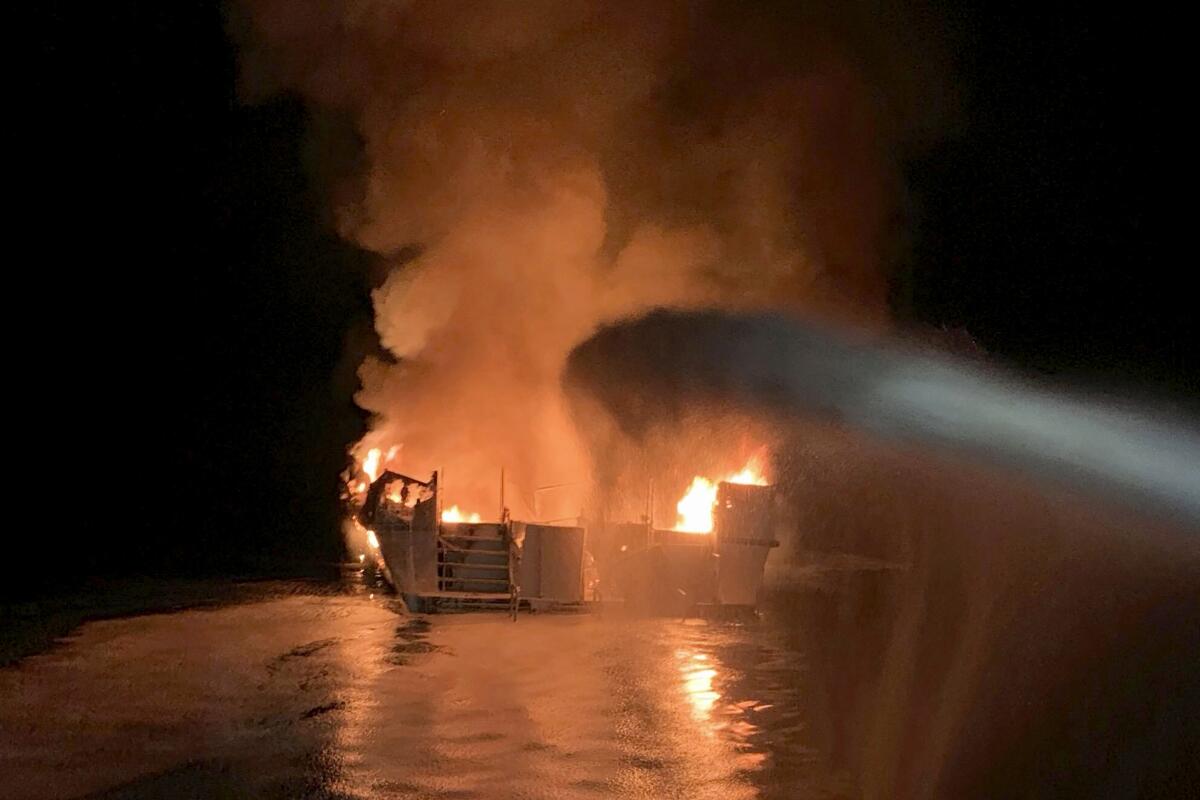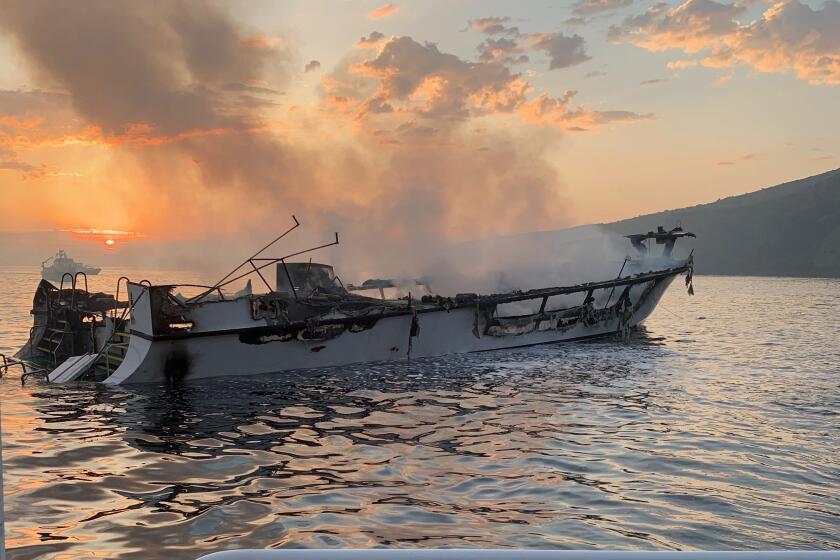More than two years after Conception dive boat fire, Coast Guard unveils new safety rules

- Share via
The U.S. Coast Guard has announced new fire safety rules for small boats more than two years after the deadliest maritime disaster in modern California history, and more than a year after Congress passed legislation requiring it to do so.
The interim rules, published Dec. 27 and set to go into effect March 28, require boat operators to install fire detection systems and extinguishers, ensure proper escape routes are available, and develop procedures for handling potentially dangerous items such as rechargeable batteries, among other requirements.
They come in response to the 2019 Labor Day fire aboard the Conception dive boat off the Channel Islands, which left 33 passengers and one crew member dead and exposed serious flaws in boat safety, later detailed by a series of Times reports and an investigation by the National Transportation Safety Board.
The new rules were expected after Congress mandated in December 2020 that the Coast Guard review its regulations for small passenger vessels. The legislation, part of the National Defense Authorization Act, directed the Homeland Security secretary to order fire safety regulations for covered small passenger vessels with overnight accommodations, excluding fishing boats and ferries.
“It is a good thing for safety and I think it will help save lives, and that is what all the families want here,” said Maggie Strom of Memphis, Tenn., whose husband, Ted Strom, died on the Conception.
In the wake of the Conception tragedy, the victims’ families banded together to help push forward reforms they believed would avoid a repeat. The group Advocacy 34 has continued to push for changes.
In a rare move, the U.S. Coast Guard has endorsed all NTSB safety recommendations for passenger boats.
Some families have been critical of regulators.
The interim regulations have a six-month comment period, and the Coast Guard still hasn’t created a requirement for safety management systems on covered vessels, said Kathleen McIlvain, whose son Charles died on the Conception.
“They work at a snail’s pace,” she said.
Under the new rules, boat operators will have to:
- Install interconnected fire detection systems in all spaces where passengers and crew have routine access, including dining areas, sleeping quarters and lounges.
- Install portable fire extinguishers on all existing vessels so that they meet the requirements in place for new vessels.
- Develop safe handling procedures for the operation and storage of potentially hazardous items such as rechargeable batteries.
- Develop crew firefighting and emergency egress training.
- Have two unobstructed means of escape that are not directly above, or dependent on, a berth.
- Ensure the escape routes on existing vessels meet the same requirements in place for new vessels.
- Install and use a monitoring device to ensure the night watchman stays awake.
- Conduct passenger emergency escape drills.
- Post a passenger safety bulletin that includes an emergency exit plan in spaces with passenger accommodations.
In September, the families of the 34 people who died aboard the Conception filed a lawsuit against the Coast Guard on the second anniversary of the deadly fire.
The suit alleged the Coast Guard failed to enforce regulations and allowed the vessel to operate with substandard electrical and safety systems that led to the deaths.
After the deadly fire, a Times investigation revealed the dive boat had been exempted by the Coast Guard from stricter safety rules designed to make it easier for passengers to escape.
An L.A. Times review of federal documents after the deadly Conception dive boat fire shows the NTSB has repeatedly called for stronger regulations, but the Coast Guard has not implemented them.
The Conception was one of about 325 small passenger vessels built before 1996 and given special exemptions from safety standards that the Coast Guard imposed on new vessels, some of which required larger escape hatches and illuminated exit signs, records showed.
The rules require vessels to have an escape hatch of at least 32 inches wide and exit signs that are illuminated.
The Conception, built in 1981, had an escape hatch that was only 24 inches wide. California lawmakers later wrote legislation mandating bigger and multiple escape hatches, and the Coast Guard’s interim rules finally codify the requirements for better egress.
A Times investigation found that before Conception, small passenger vessels had gone up in flames for a variety of reasons for nearly 20 years, prompting repeated calls by the NTSB to improve fire safety measures, but the Coast Guard ignored those recommendations.
In November 2000, an electrical malfunction caused the Port Imperial Manhattan to burn as the ferry headed to New Jersey from Manhattan. An NTSB report concluded that inadequate inspection and maintenance of the electrical system, as well as insufficient fire detection systems and crew training, contributed to the blaze.
In the Conception boat fire, an NTSB investigation found that a lack of a required night watch by the boat operators led to a failure to detect the fire earlier, but the safety agency also did not spare government regulators, finding that “contributing to the undetected growth of the fire was the lack of United States Coast Guard regulatory requirements for smoke detectors.”
Although the NTSB determined the fire began in the back of a middle deck salon where lithium-ion batteries were being charged, the agency could not say whether it was the batteries, the ship’s electrical system or an unattended fire source that ignited the blaze.
A deadly fire engulfed the Conception dive boat because its owner failed to have effective oversight of the vessel and did not operate a required roving patrol that could have detected the fire earlier and saved lives, the National Transportation Safety Board said Tuesday.
For the record:
2:36 p.m. Feb. 5, 2022This article states that the NTSB found the fire was burning for at least 30 minutes before it was discovered by crew members. Investigators say about 30 minutes elapsed between a crew member’s check of the boat’s galley, where the fire started, and the discovery of the fire. The NTSB has not determined when the fire started.
Then-NTSB Chairman Robert Sumwalt said that regardless of the source of the fire, the 33 passengers and one crew member below deck probably could have escaped if there had been early detection of the blaze. The agency found that the fire was burning for at least 30 minutes before a crew member sleeping in the wheelhouse atop the three-deck boat was awakened by a pop, crackle and the glow of the flames from the middle deck.
“It is amazing we have an unattended room with batteries charging in it, a griddle, two burners as well as a refrigerator and we have no regulation that requires smoke detectors,” NTSB Vice Chairman Bruce Landsberg said.
The agency also faulted the limited ways in which passengers below deck could escape from the blaze.
“Contributing to the high loss of life were the inadequate emergency escape,” the board said in November 2020 report on the tragedy.
When the Coast Guard announced last month that it would finally put some new rules on the books, NTSB Chairwoman Jennifer Homendy praised the move but noted more still needs to be done.
“Although there is more work to be done, including the implementation of safety management systems for passenger vessel operations, we are encouraged by the Coast Guard’s actions and look forward to reviewing the interim rules,” Homendy said.
She noted that the Conception fire helped drive the decision to add improving passenger and fishing vessel safety to the NTSB’s Most Wanted List of Transportation Safety Improvements in April 2021.
More to Read
Sign up for Essential California
The most important California stories and recommendations in your inbox every morning.
You may occasionally receive promotional content from the Los Angeles Times.













